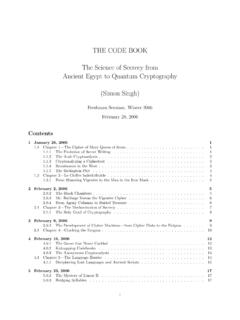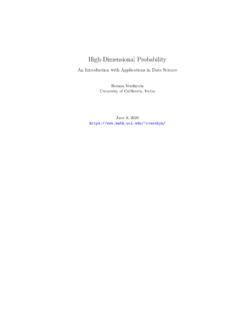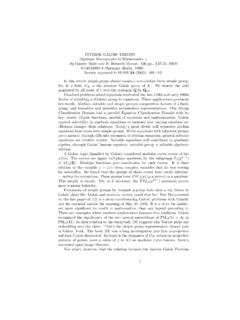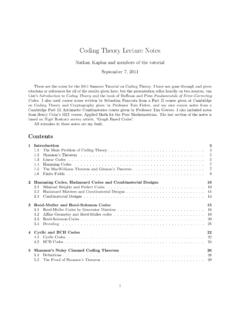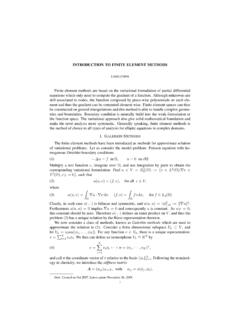Transcription of Ancient Chinese Mathematics (a very short summary)
1 Ancient Chinese Mathematics (a very short summary) Documented civilization in China from BCE. Un-til CE, China refers to roughly to the area shownin the map: north of the Yangtze and around the Yellowrivers. Earliest known method of enumeration dates from theShang dynasty ( 1046 BCE) commensurate withthe earliest knownoracle bonescript for Chinese char-acters. Most information on the Shang dynsaty comesfrom commentaries by later scholars, though many orig-inal oracle bones have been excavated, particularly fromAnyang, its capital. During the zhou dynasty ( 256 BCE) and especially towards the end in theWarring Statesperiod ( 221 BCE) a number of mathematical texts were written.
2 Most have been lost butmuch content can be ascertained from later commentaries. The warring states period is an excellent example of the idea that wars lead to progress. Rapidchange created pressure for new systems of thought and technology. Feudal lords employeditinerant philosophers1) The use of iron in China expanded enormously, leading to major changesin warfare2and commerce, both of which created an increased need for Mathematics . Indeedthe astronomy, the calendar and trade were the dominant drivers of Chinese Mathematics formany centuries. The warring states period ended in 221 BCE with the victory of victory of the Qin Emperor ShiHuang Di: famous for commanding that books be burned, rebuilding the great walls and forbeing buried with the Terracotta Army in Xi an.
3 China was subsequently ruled by a successionof dynasties until the abolition of the monarchy in 1912. While this simple description mightsuggest a long calm in which Chinese culture and technology could develop in comfort, inreality the empire experienced its fair share of rebellions, schisms and reprisals. The empire ofthe Qin dynasty was tiny in comparison to the extent of modern China, and its expansion didnot happen smoothly or without reversals. East Asia (modern day China, Korea, Japan, etc.) is geographically isolated from the rest of theworld and, in particular, from other areas of developing civilization. To the north is Siberia, tothe west the Gobi desert, southwest are the Himalaya and to the south is jungle.
4 During theHan dynasty ( BCE 220 CE) a network of trading routes known as thesilk roadconnectedChina, India and, through Persia, Europe. Indeed part of the purpose of the Great Wall wasthe protection of these trade routes. Knowledge moved more slowly than goods, and there isvery little evidence of mathematical and philosophical ideas making the journey until many1 Confucius was one such and served for a period as an advisor to Lu, a vassal state of the zhou . He died at the beginningof the warring states period, around 479 BCE, but his followers turned his teachings into a major philosophical school primary emphasis was stability and unity as a counter to turmoil. The other major philosophicalsystem dating from this time isTaoismwhich is more comfortable with change and Tzu s military classicThe Art of Wardates from this later.
5 For instance, there is no evidence of the Chinese using sexagesimal notationto aid their calculations, which meant that essentially none of Babylonian and Greek work onastronomy made it to China. Similarly, there are many mathematical ideas which saw no ana-logue in the west until many centuries after Chinese mathematicians had invented them. Itseems reasonable to conclude that Chinese and Mediterranean Mathematics developed essen-tially Mathematical TextsThe oldest suspected3mathematical text is theZhou Bi Suan Jing(The Mathematical Classic of theZhou Gnomon4and the Circular Paths of Heaven). It was probably compiled some time in the period500 200 BCE. The text contains, arguably, the earliest statement of Pythagoras Theorem as well assimple rules for computing fractions and conducting arithmetic.
6 The book was largely concernedwith astronomical calculations and presented in the form of a dialogue between the 11thcentury BCEDuke of Zhou5and Shang Gao (one of his ministers, and a skilled mathematician).As with other early texts, there is no rigorous notionof proof or axiomatics, merely strong assertions or ob-vious appeals to pictures. For instance, the proof of Pythagoras Theorem is purely pictorial: taking thesides of the triangle to bea,b,cin increasing order oflength, the picture essentially claims thatc2=4 12ab+ (b a)2giving the familiar result when multiplied course the Chinese do not attribute this result to Pythagoras! Instead it is known as thegou guwhere these words refer first to the shorter and then the longer of the two non-hypotenuse sides ofthe are several other early works; here are two of the most Shu(A Book on Arithmetic) Compiled 150 BCE, covering, amongst other topics, frac-tions, the areas of rectangular fields, and the computation of fair Zhang Suan Shu(Nine Chapters on Mathematical Arts) Written BCE 200 CE.
7 Many top-ics are covered, including square roots, working with ratios (false position and the rule of three6),simultaneous equations, areas/volumes, right-angled triangles, etc. TheNine Chaptersis a hugelyinfluential text, in no small part due to the creation of a detailed commentary and solution manual toits 246 problems written by the mathematician Liu Hui in 263 Chinese texts are extremely difficult to date: we have no original copies and most seem to have been compiledover several hundred years. Most of what we know of these texts is in the form of commentaries by later : One that knows or examines strictly the elevated piece of a sun/moondial which would have been usedfor measuring said circular paths of with writing theI Ching, the classic of changes.
8 6 Given equal ratiosa:b=c:d, wherea,b,cknown, thend= style of both text consists of laying out methods of solution which have wide application, ratherthan on proving that a particular method is guaranteed to work. Indeed there is no notion of ax-iomatics on which one could construct a proof in the modern sense of the made other contributions to Mathematics , including accurateestimates of made similarly to Archimedes. He made particu-lar use of theout-in principlewhich essentially describes how tocompare areas and volumes:1. Areas and volumes are invariant under If a figure is subdivided, the sum of the areas/volumes ofthe parts equals that of the instance, Liu gave the argument shown in the picture as analternative proof of thegao gu: the green square is subdividedand theinpiecesAi,Bi,Citranslated to new positionsAo,Bo,Coto assemble the required extended the out-in principle to analyze solids, comparing the volumes of four basic solids: Cube (lifang) Right triangluar prism (qiandu) Rectangular pyramid (yangma) Tetrahedron (bienuan)These could be assembled to calculate the volume of, say, a truncated pyramid:The Bamboo ProblemThis problem is taken from theNine Chapters.
9 Indeed the picture shows the problem as depicted in Yang Hui sfamousAnalysis of the Nine Chaptersfrom bamboo is 10chihigh. It breaks and the top touches the ground 3chifrom the base of the stem. What is the height of the break?In modern language, ifa,b,cis the triangle, we know thatb+c=10anda=3. We solution isb=12(b+c a2b+c)=91100chi: think about why..3 Chinese EnumerationThe Chinese had two parallel systems of enumeration. Both are essentially Bone Script and Modern NumeralsThe earliest Chinese writing is known asoracle bonescript dates from around 1600 BCE. The numbers 1 10 were recorded with distinct symbols, withextra symbols for 20, 100, 1000 and 10000. These were decorated to denotes various multiples.
10 Someexamples are shown system is quite complex, given all the possibilities for decoration, and therefore more advancedthan other contemporary systems. Standard modern numerals are a direct descendant of this script:Observe the similarity between the expressions for the first 10 digits. The second image denotesthe number 842, where second and 4th symbols represent 100 s and 10 s respectively: literallyeighthundred four ten zero symbol is required as a separator: one could not confuse 205 with system is still partly positional: the symbol for, say, 8 can mean 800 if placed correctly, but onlyif followed by the symbol for NumeralsThe second dominant form of enumeration dates from around 300 BCE and wasin very wide use by 300 CE.
